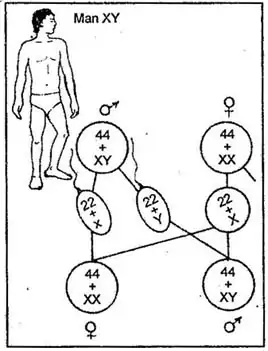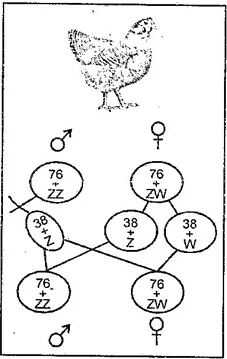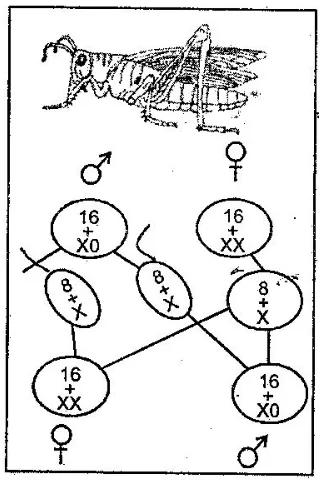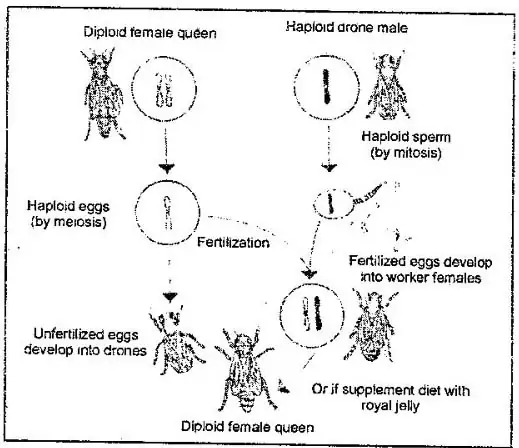Explain the Chromosomal Sex Determination Mechanisms.
The major chromosomal sex determination mechanisms aXX-XY system, ZZ-ZW system, XX-XO system, ploidy level and compound chromosome system.
The XX-XY System:
The XX-XY sex determination system is the most familiar, as it is found in humans and some plants like the angiosperm genus Lychnis. In the system, females have two of the same kind of sex chromosome (XX), thus the female is the homogametic sex. While males have two distinct sex chromosomes (XY) and is called the heterogametic sex.
The 46 chromosomes carried by humans consist of one pair of sex chromosomes and 22 pairs of autosomes (AA), the chromosomes that are not sex chromosomes. In the human male, each of the four sperm produced during gametogenesis Contains 23 chromosomes. Two sperm contain an X chromosome, and the other two have a Y chromosome.
The sex of the offspring is determined by whether the sperm that fertilizes the egg carries an X or a Y chromosome. On the basis of the studies on sex chromosomal abnormalities in man, it was suggested that the Y-chromosome helps in determining maleness.
Genes on the Y chromosome promotes the differentiation of the embryonic gonad to a testis, which results a male phenotype. Thus, presence of the Y chromosome indicates the development of male phenotype and its absence (i.e. presence of only X chromosome) determines the development of female phenotype.

The ZZ-ZW System:
For the ZZ-ZW system, which determines sex in birds and some fish, reptiles and amphibians, and in a plant species Frageria orientalis, the male chromosome is identified as ZZ and the female as ZW. The letters Z and W are used to distinguish these types of sex chromosomes from those found in the X-Y pattern of sex determination of other species. In the Z-W system, the male is the homogametic sex and the female is heterogametic. Thus, the ovum determines the sex of the resultant offspring, because all sperms carry similar chromosomes in this system.

The XX-XO System:
Another mechanism of sex determination that involves sex chromosomes is the XX-XO system that operates in many insects like the cricket and the beetle. In some insect species, the male has only one sex chromosome (the X) and is designated XO, i.e. 0 indicates the absence of one sex chromosome, whereas the female has a pair (two X’s). The ratio between X chromosomes and the number of autosomal sets determines sex. If a fly has one X chromosome and is diploid for the autosomes (2n), the ratio is 1/2, or 0.5. This fly becomes a male. If a fly receives two X chromosomes and is diploid, the ratio is 2/2, or 1.0, and the fly becomes a female.

Sex Determination by Ploidy Level:
Another interesting mechanism of sex determination, known as the ploidy or haplodiploid system, is found in bees, wasps, and ants. For example, in honeybees, the male, which is called a drone, is produced from unfertilized haploid eggs. Male honeybees contain a single set of 16 chromosomes, thus are haploid males.
They cannot undergo normal meiosis, hence produce gametes through mitosis. By comparison, female honeybees, both worker bees and queen bees, are produced from fertilized eggs and therefore are diploid. They contain two sets of chromosomes, for a total of 32. In this case, only females are produced by sexual reproduction.

In this system, a male produces only daughters. Thus daughters are identical for all the 50% of the genes received from their father, plus one half of the 50% of the genes from their mother, this makes a total of 75% genetic relatedness. Some species of lizards carry mostly triploid (3N) females and few males.
The Compound Chromosome System:
In the compound chromosome system, several X and Y chromosomes combine to determine sex. Compound chromosomal systems tend to be complex, as the group of chromosomes (eg: 8X, 12X, 6Y etc.) at the time of meiosis unite end to end and behave as single unit. A chromosome formed by the fusion of two separate, as in attached-X chromosomes or attached-X-Y chromosomes. For example, the nematode Ascaris incurva has 8X chromosomes and one Y chromosome.
The species has 26 autosomes. Males have 35 chromosomes (26A + 8X + Y), and females have 42 chromosomes (26A + 16X). There are large differences in the number of chromosomes in males and females. During meiosis, the X chromosomes unite end to end and behave as single unit. Thus, the male produces gametes that contain either 8X chromosomes or a single Y chromosome. Female produces gametes that contain 8X chromosomes.


